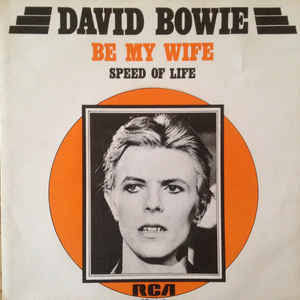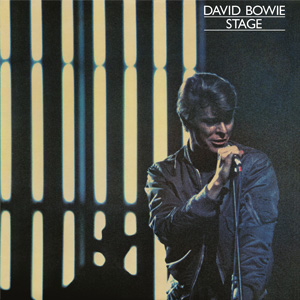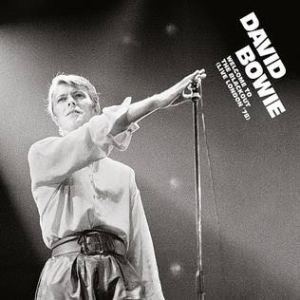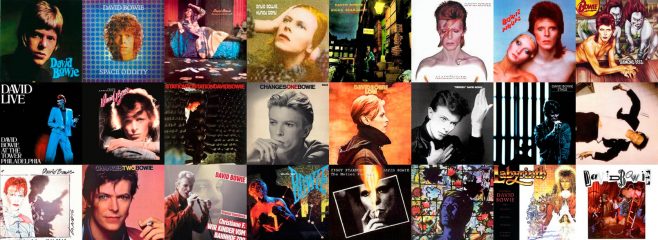
“Low” is David Bowie’s 11th studio album, originally released on 14th January 1977.
By mid 1976, David Bowie was in a very dark place. Living in LA and all consumed with drugs and the unexpected pressure of fame, Bowie was struggling just to survive. With a management that Bowie had only recently discovered was ripping him off and with a marriage that was slowly disintegrating, Bowie was feeling lost, isolated, paranoid, depressed and physically unwell. Storing your urine in a fridge in order to stave off demons is not the sign of a healthy person…
In an attempt to clean himself up and to escape what Bowie saw as the high pressure, corrupt and decadent influence of life in LA, he along with fellow rock ‘n’ roll refuge Iggy Pop moved back to Europe and a more normal life in the (then) isolated world of Berlin, Germany. That it was considered one of the most decadent and drug influenced cities in Europe was perhaps a little unfortunate, but with its art and night-life culture, it was perfectly suited to a Bowie in desperate need of a positive change.
After being impressed with the recent works of ex Roxy Music member Brian Eno with albums such as the brilliant “Another Green World” and ambient pieces such as “Discreet Music“, Bowie was keen to team up and move in a new musical direction. Bowie had recently released the superb disco-funk that was the “Station to Station” album, where The Thin White Duke did indeed introduce a few European influenced electronic soundscapes. Bowie saw Eno as the perfect partner to help with making more European influenced electronic music as per German Krautrock bands such as Tangerine Dream, Neu! and Kraftwerk.
After getting Eno’s commitment, Bowie then contacted his previous producer Tony Visconti and asked what he could add to their musical exploration. Visconti mention he had just discovered a machine, the Eventide Harmonizer, that can make the drum sound fuck with the fabric of time. He was in.
Along with the same rhythm section from the “Station to Station” sessions (Carlos Alomar, Dennis Davis and George Murray), Bowie then recruited Ricky Gardiner (from Beggars Opera) on guitar and Roy Young on piano. The band was now complete.
Recorded mostly at the Château d’Hérouville studios near Paris (where he previously recorded “Pin-Ups”), Bowie and co would go on to record one of the most astonishing and influential albums of all time.
Side one would consist of slightly more rock oriented type tracks, but more instrumental in nature with those featuring any lyrics having a sense of being added more as an afterthought. Side two however would consist of purely electronic, instrumental, ambient pieces with Bowie’s vocals but another instrument rather than conveying “words” with any meaning. The overall effect was stunning, other worldly and totally unlike anything previously heard in the Bowie cannon.
The album opens with “Speed of Life“, an instrumental that seems to start midway through, as if we missed the start and boarded part way through. Featuring the rhythm section and a weird, electronic pulsing melody, we heard the unique drum sound for the first time, with the pitch of the drum dropping sharply each time Dennis Davis hits the skins. It just sounds mesmerising but before we know it, the track fades away, again giving the sense we’ve only been allowed to witness a part of the track.
“Breaking Glass” then kicks in, with the wonderful drum sound and treated guitar sound dominating, with electronic swashes of sound moving across the speakers. We hear Bowie for the first time, lamenting some awful things he’s doing to a room in which the owner is ignoring him. We hear Bowie’s anguish at his isolation, a theme he repeatedly comes back to throughout the album. Interestingly, this is the only track on Side one not written just by Bowie, with both Dennis Davis and George Murray listed as co-writers.
But again, before we know it, we’ve moved on to “What in the World“, a more up tempo number, in which the tempo increases as the track progresses. Again, sung in a mournful manner (with Iggy Pop on background vocals), it’s another song on the topic of human rejection.
We then hit the three song cycle which is at the heart of the album and among the best songs Bowie has ever recorded. Beginning with the wonderful “Sound and Vision“, with it’s catchy riff the rhythm section have never sounded quite as good as this. Add in Eno’s synthesizers and it sounds so damn good. Bowie’s deep intro vocals don’t make an appearance until about half-way through the song, the split harmonised vocal detailing the sadness of sitting in a bedroom alone. It’s both sad and beautiful at the same time and a Bowie classic. Released as the lead-off single, Bowie didn’t bother with making a video but this didn’t stop it being a No. 3 hit in the UK and elsewhere in Europe, although it flopped in the US as feared by RCA, reaching only No. 69.

“Always Crashing in the Same Car” comes next with it’s theme of isolation and attempted suicide. The music here is more electronic in nature, with the keyboards and synthesizers dominating more, although the drum work of Dennis Davis is just superb. It’s again eerie, sad but ultimately one of the most beautiful tracks Bowie has ever recorded, The amazing guitar solo at the end (only of two on the album) just gives it that added magic and finish. A Bowie highlight.
“Be My Wife” ends Bowie’s conventional vocals on the album, a song of despair and rejection as the plea to be his wife is ignored. Featuring an almost bar-room like piano by Roy Young, again the combination of the fantastic rock rhythm section, the shrieking guitar solo and electronic soundscapes creates a simply gorgeous sound and atmosphere. Released as the second single off the album, Bowie made one of his most bizarre videos ever, with a gaunt, lonely Bowie in a white studio miming (badly) along with the track on a guitar. Bowie’s facial expressions are both hilarious and somewhat frightening at the same time. It’s a must see here. Unsurprisingly, the single was a flop just as RCA had again feared, the first Bowie single not to chart in the UK since “Changes” in 1971.

Side one ends with “A New Career in a New Town“, another instrumental to bookend side one. It’s possibly the most “up” of all the tracks so far, conveying a feeling that Bowie is indeed looking at a new career in his new town of Berlin. Featuring Bowie’s harmonica and a rather nice keyboard hook, it has a bouncy feel, with the rhythm section making their last appearance on the album. It featured as the opening music on Bowie last “Reality” world tour and has always been a personal favourite of mine.
If Side one was a little “down”, with Bowie’s vocals only infrequently on display, wait until you hit Side two. Starting with the stately “Warszawa” (its title based on Warsaw, Poland), it’s a very slow, atmospheric piece invoking the dreariness and desolation of Warsaw. Only Bowie and Eno play on this piece, with it’s layered synthesizers and keyboard the only instruments. Except that is Bowie’s vocals, that appear near the end. But here, Bowie doesn’t sing “words”, but are purely phonetical and helps create the sense of quiet desperation of the piece. The influence here of Brian Eno is obvious, although it’s worth noting this is Eno’s only co-writing credit and despite popular opinion, Eno didn’t share the producer’s chair, with Bowie/Visconti the only co-producers.
Next comes “Art Decade“, another slow instrumental piece that has a rather lovely, melancholy keyboard melody, but within a backdrop of weird, electronic soundscapes. The attempt here is to convey the feeling of a street Bowie encountered in Berlin and the isolation he felt, the title a play on “Art Deco”.
“Weeping Wall” with its obvious reference to the Berlin wall is based in part on the melody of “Scarborough Fair” by Paul Simon. A beautiful atmosphere piece, with all sorts of sounds present, including an upfront xylophone, it’s the only track on the album that is played exclusively by Bowie. The musicianship of Bowie is often understated but he could play numerous instruments and does so very effectively here. Again, Bowie’s vocals are present on this track, but only as another instrument is add another layer to the overall atmosphere.
The album closes with the sublime “Subterraneans“, another beautiful, sad piece that was initially destined to be part of the soundtrack to “The Man Who Fell To Earth” that starred Bowie, before Bowie’s involvement in the soundtrack was abandoned. Featuring lovely synthesizers flourishes, Bowie’s stunning saxophone and most effectively, Bowie’s amazing phonetic vocals, it’s the glorious musical highlight of the album. I LOVE this track.
Listening to “Low” for the first time is an amazing experience and I encourage anyone who hasn’t had the joy of listening to this album to give it a go. Yes, it’s all rather sad and melancholy in character but it really is an amazing musical experience.
That said, Bowie’s record company at the time (RCA) hated it and initially refused to release it. The lack of Bowie vocals and the avant-garde nature of the music had RCA worried that it would be a commercial disaster. Bowie’s management of the time, Mainman who had a big stake in the monies made also hated it and tried to stop the album from being released as well. This delayed the eventual release of the album until January 1977, which ironically hurt sales as it meant missing the Christmas shopping period. It did OK however, reaching No. 2 in the UK and a respectable No. 11 in the US, although this started a decline in the US album market until the commercial monster that was “Let’s Dance” in 1983.
Although there was some confusion and uncertainty over the album at the time, the music press were generally favourable, with critic acclaim over the album only increasing over time.
The iconic album cover was another still shot from the movie “The Man Who Fell To Earth” that Bowie starred in and which obviously had a big impact on Bowie, with another still from the movie previously used on the cover of “Station to Station”. The album “Low” with a profile shot of Bowie could be interpreted as “Low Profile”, get it !!
As part of the brilliant Ryko 1991 CD re-release, two new tracks from the Berlin period were included as bonus tracks:
“Some Are“, a rather quiet piano based track with nice electronic soundscapes (not unlike Warszawa if truth be told), that features actual vocals, albeit obscure ones:
“Sailors in snow
Send a call out raising hands
Some are bound to fail
Some are winter sun, ah”
It’s a nice enough piece that came as a pleasant surprise when released.
“All Saints” is an instrumental, that has an industrial edge to it with brooding, pulsing synthesizers and reminds me somewhat of some of the tracks Bowie did with Iggy Pop. Again, a nice new surprise at the time of the re-release but not exactly an essential track to add to the Bowie collection.
Bowie would tour “Low” (and “Heroes” and a good chunk of Ziggy Stardust) the following year as part of the Isolar II world tour, the largest Bowie tour to date that finally included Australia for the first time.
The resultant “Stage” live album was another way to enjoy several of the tracks off “Low”, although the album was criticised (somewhat unfairly) as sounding almost identical to the actual album versions with some background crowd noise due to the superb musicianship on display. The 5.1 remix released on DVD in 2005 is well worth a listen and adds another dimension to the tracks. Imagine starting a concert with “Warszawa”, only Bowie could get away with it.

In 2018, another live album from the Isolar II tour was released, “Welcome to the Blackout“. Recorded in London, it’s another fine album that captures Bowie at his classic best with “Warszawa”, “What In The World”, “Be My Wife”, “Speed Of Life”, “Sound and Vision”, “Breaking Glass” and “Art Decade” all sounding just perfect.

In many ways, “Low” was perhaps the most challenging and risky move of his career. But ultimately, it was also perhaps one of his most important albums as it became the blueprint for the post-punk period and music for the next 10 years and beyond. Bands such as Joy Division, Ultravox, Visage, Duran Duran, Spandau Ballet, ABC, Depeche Mode, Gary Numan, etc. etc. etc. and the whole New Romantics movement and then beyond with NIN, Radiohead, Muse, etc. etc. etc. all owing a huge debt to “Low”.
Bowie would go on to make two more albums with Eno to complete the so-called “Berlin Trilogy”, before working with Eno again in 1995 on the masterpiece that is “1. Outside“. But that’s a story for another day.
Best Tracks: “Sound and Vision”, “Always Crashing in the Same Car”, “Be My Wife”
